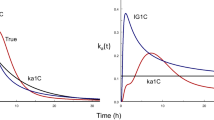Summary
In a study of eight volunteers and six patients, glibenclamide was placed at different sites of the gastro-intestinal tract under visual control. The dose was instilled once into the stomach and once into the duodenum of the eight volunteers in a randomized crossover design. The six patients underwent diagnostic colonoscopy, and the dose was placed into the ascending colon if pathological findings were not present.
The area under the concentration-time curve, completed by extrapolation, and the mean residence time of the drug in the body were calculated. These pharmacokinetic characteristics were examined using a Jonckheere test for ordered alternatives and a Wilcoxon signed rank pair test.
The means of the areas under the curve were 477±131 ng·h ml−1 for the stomach, 475±142 ng·h ml−1 for the duodenum and 486±301 ng·h ml−1 for the colon. The mean residence time changed from 2.67±0.35 h for the stomach to 2.42±0.48 h for the duodenum and 3.55±0.68 h for the colon.
These results indicate that although glibenclamide is absorbed from all three sites of the gastro-intestinal tract to the same extent, the rates of absorption are different. It is discussed whether these findings really confirm the pH-partition hypothesis in drug absorption. Since glibenclamide — a weak acid — has a pK-value of about 6.5, these data seem to confirm the pH-partition hypothesis of drug absorption.
Similar content being viewed by others
References
Blume H, Ali SL, Siewert M (1984) Zur pharmazeutischen Qualität von glibenclamidhaltigen Fertigarzneimittlen. Pharm Z 129 [17]: 983–989
Bowman WC, Rand MJ, West GB (1967) Textbook of pharmacology. Blackwell, London
Brockmeier D (1984) In vitro — in vivo correlation, a time scaling problem? III. Evaluation of mean times. Arzneimittelforsch/Drug-Res 34 [II]: 1604–1607
De Boer AG, Moolenaar F, De Leede LGJ, Breimer DD (1982) Rectal drug administration: Clinical pharmacokinetic considerations. Clin Pharmacokinet 7: 285–311
Dost FH (1958) Über ein einfaches statistisches Dosis-Umsatz-Gesetz. Klin Wochenschr 34: 655–657
Dost FH (1964) Ein neues Verfahren zur Ermittlung des Umsatzes von Stoffen exogener und endogener Herkunft im Blut ohne Kenntnis der Distribution. Antibiot Chemother 12: 149–158
Hajdú P, Kohler KF, Schmidt FH, Springler H (1969) Physikalisch-chemische und analytische Untersuchungen an HB 419. Arzneimittelforsch/Drug Res 19: 1381–1386
Heptner W, Badian M, Baudner S, Hellstern C, Irmisch R, Rupp W, Weimer K, Wissmann H (1984) A radioimmunoassay for determination of glibenclamide and other sulfonureas. Pharm Res 1 [5]: 215–220
Hogben CAM, Tocco DJ, Brodie BB, Schanker LS (1959) On the mechanism of intestinal absorption of drugs. J Pharmacol Exp Ther 125: 275–282
Jonckheere AR (1954) A distribution-free k-sample test against ordered alternatives. Biometrika 41: 133–145
Kruis W, Bull U, Eisenburg J, Paumgartner G (1982) Retrograde colonic spread of sulphasalazine enemas. Scand J Gastroenterol 17: 933–938
Kübler W (1965) Qualitative Blutspiegeluntersuchungen über die Kinetik der Dünndarmresorption. Gastroenterologia 104 [Suppl]: 231–235
Kuna S (1964) The pH of gastric juice in the normal resting stomach. Arch Int Pharmacodyn 152: 79–97
Manninen V, Melin J, Apalathi A, Karesoja M (1973) Altered absorption of digoxin in patients given propanthelie and metoclopramide. Lancet 24: 398–400
Meldrum SJ, Watson BW, Riddle HC (1972) pH profile of gut as measured by radiotelemetry capsule. Br Med J 2: 104–106
Meyer BH, Müller FO, Grigoleit H-G, Heptner W (1982) Endoscopic placement in volunteers to investigate site of absorption of piretanide: Preliminary report. IRCS Med Sci 10: 14
Nimmo J, Heading RC, Tothill P, Prescott LF (1973) Pharmacological modification of gastric emptying. Effects of propantheline and metoclopramide on paracetamol absorption. Br Med J 10: 587–589
von Hattingberg HM, Brockmeier D, Voegele D (1980) A method for in vivo — in vitro correlation using the additivity of mean times in biopharmaceutical models. In: Rietbrock N, Woodcock BG, Neuhaus G (eds) Methods in clinical pharmacology. Vieweg, Braunschweig, Wiesbaden, pp 85–93
von Hattingberg HM, Brockmeier D (1982) A concenpt for the assessment of bioavailability in complex systems in terms of amounts and rates. In: Bozler G, van Rossum JM (eds) Titisee Conference. Pharmacokinetic during drug development: Data analysis and evaluation techniques (Oct. 1978). Gustav Fischer, Stuttgart, pp 315–323
Author information
Authors and Affiliations
Rights and permissions
About this article
Cite this article
Brockmeier, D., Grigoleit, H.G. & Leonhardt, H. Absorption of glibenclamide from different sites of the gastro-intestinal tract. Eur J Clin Pharmacol 29, 193–197 (1985). https://doi.org/10.1007/BF00547421
Received:
Accepted:
Issue Date:
DOI: https://doi.org/10.1007/BF00547421




